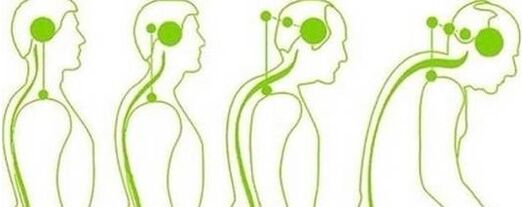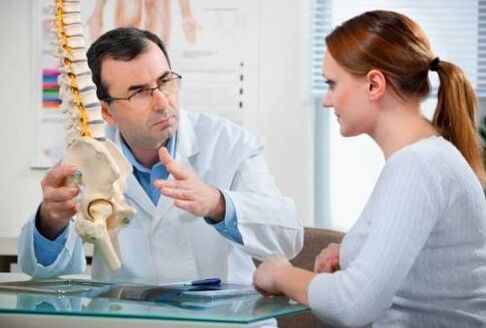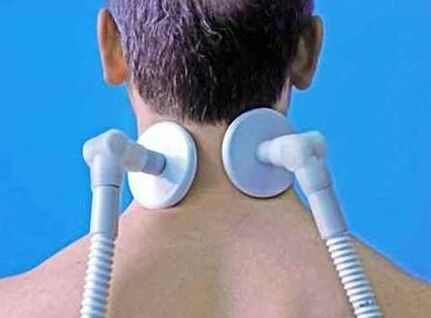Cervical osteochondrosis most often develops in adults, but due to certain circumstances, a child can occur. When any signs of such a disease occur, you should contact a therapist or neurologist with a narrow profile.
The degenerative-dystrophic destruction of the cervical disc of the spine characterizes the cervical osteochondrosis. The gradual progression of the disease leads to damage to the intervertebral joints, adjacent vertebrae and ligamentary apparatus. Many mistakenly believe that osteochondrosis is the deposition of salts. However, such a statement is radically wrong. Salt can really be delayed in different joints, but for example, with other pathologies due to the development of gout.
Thanks to the muscular system, the spine of the human neck is held, consisting of seven vertebrae. In this area, the muscles are poorly developed, which is why, due to long -term tension, fatigue occurs and cramps occur. In the future, the mobility of the cervical vertebrae becomes limited. As a result of this condition, spinal discs are gradually destroyed, which provokes the onset of the first stage of osteochondrosis. In the absence of treatment, the disease is constantly progressing, causing all the larger lesions of the spine. In order to prevent the development of complications, it is necessary to pay attention to the first signs of pathology on time and to take appropriate measures.
Most often, people like cervical osteochondrosis are facing people whose lifestyle provides a minimum of physical activity and sedentary work. In such a person, the most likely characteristics may already occur at the age of 25-30 years. Among the children from the baby to adolescence, the disease is more common, but it can also occur due to improper lifestyles or heredity, other irritating factors.
The whole process of developing osteochondrosis of the cervical spine is divided into 4 main stages, each accompanied by certain symptoms. Treatment is completely dependent on the established severity of the disease. For example, the first, preclinical stage does not require medication treatment. In order to improve the patient's condition, it is recommended to radically review the lifestyle - to exercise and to eat properly. The characteristics characteristic of this stage: excessive tension of the muscles of the whole back, the rapid appearance of fatigue, mild but tangible pain in the moments of turns and inclinations of the head. The main disadvantage in this case may distinguish the fact that few people attach due importance to such symptoms, so they do not immediately turn to the hospital.
The following symptoms are characteristic of osteochondrosis in the second degree:
All of the above symptoms cannot continue to go unnoticed, therefore, at the bigger part, at this stage of the disease, the patient seeks medical help. The strengthening of the pain is due to a decrease in the distance between the intervertebral discs and the disruption of the nerves. Even more worsening the situation happens at the third stage. In this case, the neck pain is constantly worried, the muscles of the hands become very weak, occasionally numbness occurs. As for the common symptoms, dizziness and weakness become the patient's daily satellites. The cervical spine loses mobility.
Unbearable neck pain, shoulders, arms, ears in the ears, complete impaired coordination and the appearance of obvious signs of other diseases indicates the onset of the final, fourth stage of osteochondrosis. At the same time, the intervertebral discs are destroyed and the pathological process moves further on the spine, affecting other departments. Such a degree of disease is difficult to treat, while at the discretion of the doctor, surgery may be required. Thus, with the onset of such symptoms as: neck tenderness and crunching during head movements, hands of the hands, dizziness, nausea, headache, hands, and fatigue and coordination problems should become an alarming signal showing real health problems. Do not delay a visit to your doctor, it is best to contact a therapist or immediately to a neuropathologist.
In the course of the progression of cervical osteochondrosis, a spinal cord disturbance may occur. Various sensitive and motor disorders may occur, depending on which spine that has suffered:
The protruding edges of the vertebrae can pull out the arteries through which the blood enters the brain. In this way, blood circulation in the brain is impaired and additional symptoms occur: a sudden change in mood, insomnia, unobstructed anxiety, fear, irritability. At the same time, with spasm of blood vessels, not only headaches, but also eye pain can happen. Patients often note the appearance of "flies" in the eyes, sometimes seizure is possible.
The most common cause of cervical osteochondrosis is considered to be a sedentary lifestyle in relation to improper, unbalanced nutrition. Often not only lazy people suffer from their nature, but also those whose profession it obliges most of the time to spend or in the same uncomfortable posture: office employees, vehicle drivers, etc. Such a way of life provokes a constant load of the cervical vertebrae, which is why muscle spasms arise. The appearance of degenerative processes in the discs is due to a violation of metabolic processes and blood circulation. Other reasons for the development of cervical osteochondrosis include:
Too zealous sports, which means too intense physical activity, can also become the previous factor in cervical osteochondrosis. Primary disease in such conditions is the most often disc. The latter characterizes dystrophic disorders in intervertebral discs, mainly lumbar and cervical discord. Osteochondrosis in this case is a consequence of a disc. In addition to the exclusion of heavy physical activity, this diagnosis requires complex treatment, medicine and physiotherapy treatment. 
Among the complications that can occur with the development of osteochondrosis of the cervical region, it must be distinguished:
Cervical osteochondrosis always causes an increase in blood pressure. In addition, the transition of the underlying disease from one stage to another contributes to the progression of hypertension from the first to the third degree, from which the pressure exceeds the marking of 180 mm. Treatment directly hypertension helps to reduce the severity of the symptoms, but only temporarily. If osteochondrosis is not cured, it is impossible to get rid of high blood pressure. In the case of discomfort between 4 and 5 cervical vertebrae, periarthritis occurs as a complication. It characterizes the pinching of the nerves located in the connection of the shoulder joint with the arm. At the same time, severe pain occurs in the shoulder, with a negative effect on the mobility of the entire limb. Also, the manifestations of osteochondrosis cannot be based on signs of heart disease, for example, angina, but thanks to diagnostic measures it is possible to distinguish diseases with high accuracy.
It is impossible to determine osteochondrosis of the cervical spine by palpation and as a result of a visual medical examination. Based on the story collected, the doctor can only assume that osteochondrosis has become a cause of certain symptoms. A diagnosis is needed to confirm or refute such assumption. The most optimal way today is NMR or magnetic resonance therapy. This method allows you to look at all bone structures, to identify the presence of intervertebral hernias, the size of osteophytes and other complications characteristic of cervical osteochondrosis. Another, slightly less informative way, is computed tomography. It allows you to make a diagnosis, but determining the size of the hernia, as its presence can be difficult.
Treatment of osteochondrosis of the cervical region is always complicated and complicated. Its duration and saturation depends on the stage of development of the disease, on the individual characteristics of the patient and the presence of other concomitant diseases. Among the main groups of medicines, which are often prescribed in the second and additional stage, should be distinguished:
The complex of these drugs is a symptomatic treatment. Following all the doctor's recommendations and the passage of the prescribed course will help eliminate the pain and get rid of all the unpleasant manifestations of the disease. However, the therapeutic course does not end there. When the main characteristics are eliminated, which impairs the quality of life, you can absorb the restoration of the cervical region to minimize the risk of recurrence of the disease in the near future. Unfortunately, a huge mistake of many people is that after the symptoms disappear, they consider themselves to be completely healthy and give up treatment. In this situation, osteochondrosis will surely remind myself after a while.
The following physiotherapy procedures are successfully used to treat cervical osteochondrosis:
Each of the above procedures has a number of contraindications, which is especially important for those who have a history of other diseases that are not related to osteochondrosis of the cervical spine. The decision on the appropriateness of the use of a particular method remains with the doctor. It may not be safe to take such measures on your own free will. As for traditional medicine, you can use the grass on the sword, bran. FIG. It is also recommended to reduce salt intake. The responsible approach to the treatment of cervical osteochondrosis will allow you to get rid of the disease for sure. Let this process take considerable time, but only complex therapy will reduce the likelihood of re -developing the disease to a minimum.

























